Waste management in schools
Save on commercial waste collection quotes today
Just enter your postcode…
Save on commercial waste collection quotes today
Just enter your postcode…
Start saving now
Exploring different waste management solutions for schools isn’t just about complying with waste regulations; it’s an opportunity to save money, reduce environmental impact, and experience excellent customer service.
Compare now and benefit from:

Compare waste service providers to find competitive rates and flexible services tailored to your needs.

Find the most sustainable waste options to reduce your carbon footprint, minimise landfill waste, and support your school’s environmental goals.

Assess waste collection providers’ reputations and track records to ensure reliable, high-quality service delivery.
Effective school waste management is pivotal in shaping sustainable practices within educational settings.
Explore how strategic approaches to managing waste can streamline operations and cultivate a culture of environmental responsibility among students and staff.
Dive into the various techniques, tools, and policies that ensure your school’s waste management system is efficient, environmentally friendly, and aligned with educational goals.
We will cover the following subjects in detail:
Discover the six primary waste disposal services essential for schools and colleges. Adhering to duty of care regulations, each recycling category must be properly segregated to prevent contamination with other types of waste.
This section will guide you through best practices for efficient waste separation and management, helping your institution enhance its sustainability efforts and comply with environmental standards.

Schools produce paper and card waste through printing and photocopying educational materials and creating arts and crafts projects.
These often use various paper materials and distribute paper notices, flyers, and newsletters to students and parents.
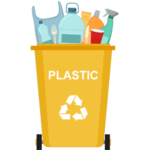
Schools generate plastic waste through disposable canteen items and plastic-based classroom supplies.
Plastic waste includes plastic folders and binders, but also from students using plastic bottles of water, soft drinks, and food packaging, such as sandwich containers.
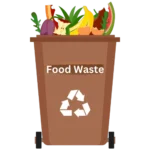
Students primarily contribute to food waste through uneaten homemade lunches and cafeteria meals.
Excess food prepared by cafeterias beyond consumption needs and overbuying perishable supplies that spoil before use also add to this waste.
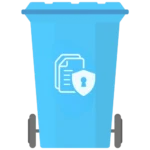
Confidential waste in schools includes student records with personal and academic information, staff documents detailing employment and payroll data, and exam materials intended to remain secure until their official release.
Proper disposal of this waste is crucial to prevent data breaches and maintain confidentiality.
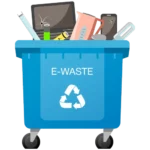
Schools generate electronic waste primarily through the fast ageing cycle of computers and laptops increasingly used by students and staff.
These dead devices can be recycled with one-off collections.

Schools continue using ink cartridges because they rely on printers and photocopiers to create essential educational and administrative documents. Printed materials remain widespread for handouts, tasks, and exams despite digital advancements.
In this section, effective waste minimisation strategies are tailored for educational settings.
Learn how schools can implement recycling, digital documentation, and other sustainable practices to reduce environmental impact and instil eco-friendly habits in students.
Discover practical steps that transform schools into models of sustainability for future generations.

Organic waste, such as food scraps and yard trimmings, can be composted to reduce waste and create nutrient-rich soil for school gardens.
Composting programs can serve as hands-on science lessons for students.

Opting for durable, repairable, and recyclable products supports waste reduction. Schools can prioritise buying supplies made from recycled materials or goods with minimal packaging.

Organising school events without generating waste encourages planning and creativity. This includes using digital tickets, reusable decorations, and serving food with minimal packaging.

Encouraging students to repurpose old or unused items into new products reduces waste and fosters creativity and problem-solving skills. This can be integrated into art and science curricula.

Reducing paper use by switching to digital communications and assignments can significantly reduce paper waste.
Schools can implement systems for electronic homework submissions, notices, and newsletters.
Each year, primary schools in England produce 68,000 tonnes of food waste, while secondary schools generate 28,000 tonnes, for a total of 96,000 tonnes annually.
Discover the critical role of commercial bins in managing school waste efficiently.
This section outlines the commercial waste bins types suitable for an educational environment and discusses their strategic placement to maximise usage and effectiveness.
From recycling to general waste, learn how to optimally position these bins around school premises to support robust waste management practices and promote a cleaner, greener school environment.
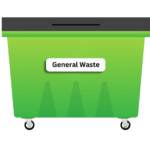
Placement: Classrooms, offices, corridors, and outdoor areas.
Common Materials: Non-recyclable waste such as wrappers, polystyrene, and contaminated paper.
Reason: To collect waste that cannot be recycled or composted, minimising litter and maintaining a clean school environment.

Placement: Classrooms, libraries, staff rooms, and near printers or photocopiers.
Common Materials: Paper, cardboard, plastic bottles, cans, and glass.
Reason: To separate recyclable materials from general waste, facilitating effective recycling practices and reducing the volume of waste sent to landfills.
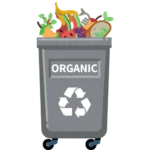
Placement: Canteens, kitchens, and nearby food preparation or eating areas.
Common Materials: Food scraps, fruit peels, coffee grounds, and biodegradable paper.
Reason: To collect organic waste for composting, which can be used in school gardens or grounds, teaching sustainability and reducing organic waste in landfills.

Placement: Administrative offices, IT classrooms or special collection points accessible during specific events.
Common Materials: Used batteries, old electronics such as calculators, computers, and mobile phones.
Reason: To safely dispose of electronic waste, preventing harmful chemicals from contaminating the environment and recovering valuable materials for reuse.
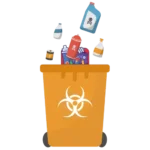
Placement: Science labs, maintenance areas, or other secure locations.
Common Materials: Chemicals, paints, solvents, and cleaning agents.
Reason: To handle dangerous materials that require special disposal methods to prevent harm to students, staff and the environment.

Placement: Common areas or entrance lobbies.
Common Materials: Books, uniforms, sports equipment, and other reusable items.
Reason: To encourage reuse and sharing of good condition items within the school community, reducing the need for new resources.
Like all businesses and other organisations, schools in the UK are legally required to adhere to the waste hierarchy: prevention, preparation for reuse, recycling, recovery, and disposal.
Here is a summary of how DEFRA’s latest guidance on applying the Waste Hierarchy applies to the education sector:
Schools and universities can significantly reduce waste by minimising paper use in the learning environment.
Digital learning platforms offer a waste-free alternative to paper worksheets. Similarly, going paperless in educational administration has many operational advantages and significantly reduces paper, confidential waste, and ink cartridge usage.
The UK education sector is being transformed by adopting digital technology in the learning environment. Unfortunately, the lifespan of IT equipment in education can be short due to its intensive use in multiple classes each day.
A dedicated IT function can focus on repairing damaged equipment, thereby avoiding the need to purchase replacements and dispose of commercial electronic waste.
The key to maximising recycling in schools is ensuring the appropriate segregation of the various types of waste.
Providing separate waste bins for each recycling category in the classroom and actively encouraging students to use them helps prevent the cross-contamination of waste, which can hinder recycling efforts.
Composting food waste, such as scraps from the school canteen, can be a valuable educational tool. It demonstrates direct waste recovery and produces compost that can be used to fertilise gardens within the school’s grounds.
Even if you follow best practices for waste management at your school, you’ll still need to dispose of various types of waste.
A reputable commercial waste collection company will provide appropriate waste bins to store your waste before their regular collections.
Your provider will give you a waste transfer note to demonstrate you’ve fulfilled your compliance obligations in disposing of the waste produced at your school.
According to Waste Watch – a leading UK environmental charity, here’s a summary of the most significant barriers to effective waste management in schools:
As schools face the growing challenge of significant waste generation per pupil, adopting innovative and effective strategies to tackle this issue head-on is essential.
This section explores various approaches that educational institutions can implement to reduce the environmental footprint of their waste management practices.
From enhancing recycling initiatives to embracing digital solutions and educating students about sustainable habits, discover how schools can transform their waste challenges into opportunities for environmental stewardship and practical learning.
Find the key statistics contributing to the issue of waste management in schools:

Figures indicate that the education sector only recycles around 23% of its waste. Primary schools generate about 45kg of waste per pupil, while secondary schools produce 22kg per pupil. This totals 250,000 tonnes of waste every year
Addressing the challenges of waste management requires targeted strategies that reduce waste and foster a culture of sustainability.
💡 The majority of food waste in both secondary (77%) and primary (78%) schools was found to be avoidable.
Explore practical solutions that can transform waste management from a logistical challenge into a learning opportunity and environmental commitment.
Due to various educational and operational practices, primary schools typically produce more waste per pupil than secondary schools. Younger students frequently participate in craft-based activities using materials like paper, glue, and plastic, significantly increasing waste.
Primary curricula also depend heavily on physical materials such as worksheets and handouts, unlike secondary schools, which often use digital resources and textbooks.
Primary pupils generally have less awareness and responsibility regarding their waste habits, leading to higher food waste and extensive use of single-use snack packaging.
Adopting disposable dining ware for safety and convenience also contributes to increased waste.
Secondary students are better equipped to engage in sustainability efforts, actively participating in recycling programs and opting for durable, reusable items.